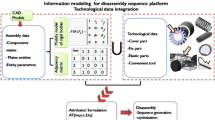Abstract
Assembly/disassembly (A/D) simulations are important to improve designs and efficiency of product development processes. In order to get efficient simulation processes it is important to simulate all the possible relative movements between the components in a mechanical system (assembly). This is important both in the context of interactive simulation and in the context of immersive/real time simulations. If some categories of movements are missing, simulations can loose key configurations, hence they may be no longer meaningful. This paper deals with a theoretical framework for developing of a kinematical model able to represent all the valid relative movements of a reference component with respect to its surrounding ones, which form a family of trajectories. It is based on the analysis of the three basic movements: translation, rotation and helical movements. In order to determine the compatibility between different families of trajectories, a bi-quaternion is associated to each contact area between the different components. All possible trajectories for each component are analyzed, for the three basic type of movements, in order to find the compatible ones, which leads to the specification of an operator. Thus, the results of all the possible associations are determined and a general combination operator is proposed and its properties are demonstrated. This operator can form, in a real time simulation environment, the basis for determining at each moment, the valid movements between components, thus reducing the complexity of collision detection algorithms.
Similar content being viewed by others
References
Angeles J.: The application of dual algebra to kinematic analysis. In: Angeles, J., Zakhariev, E. (eds) Computational Methods in Mechanisms, vol. 161, pp. 3–31. Springer, Heidelberg (1998)
Alba, P., McCarthy, J.M.: Dual quaternion synthesis of parallel 2-TPR robot. In: Proceedings of the Workshop on Fundamental Issues and Future Research on Mechanisms, pp. 101–108 (2002)
Brough J.E., Schwartz M., Gupta S.K., Anand D.K., Kavetsky R., Pettersen R.: Towards the development of a virtual environment based training system for mechanical assembly operations. Virtual Real. J. 11, 189–206 (2007)
McCarthy J.M.: Quaternions and Motion interpolation. An Introduction to Theoretical Kinematics. MIT press Cambridge, Massachusetts (1990)
McCarthy J.M.: An Introduction to Theoretical Kinematics. MIT Press, Cambridge (1990)
George V., Paul P., Katsushi I.: Representing the Motion of Objects in Contact Using Dual Quaternions and its Applications, pp. 53–61. Robotics Institute, Carnegie Mellon University, Pennsylvania (1997)
de Sa Gomes A., Zachmann G.: Virtual reality as a tool for verification of assembly and maintenance processes. Comput. Gr. 23(3), 389–403 (1999)
Hamilton W.R.: On quaternions and the rotation of a solid body. Proc. R. Ir. Acad. 4, 37–56 (1850)
Hamilton,W.R.: Elements of quaternions, Vol. 1. 3rd edn. Chelsea Publishing Company, (1969)
Iacob, R., Mitrouchev, P., Léon, J-C.: A simulation framework for assembly/disassembly process modelling. ASME’2007, IDETC/CIE Conference, September 4–7, Las Vegas, Nevada, USA (2007)
Iacob, R., Mitrouchev, P., Léon, J-C.: Contact identification for assembly/disassembly simulation with a haptic device. The Visual Computer, ISSN: 0178-2789, Springer, Berlin, pp. 973–979 (2008)
Jayaram S., Connacher H.I., Lyons K.W.: Virtual assembly using virtual reality techniques. J. Comput. Aided Des. 29, 575–584 (1997)
Kopena, J., Regli, W.C.: Extensible semantics for representing electromechanical assemblies. In: Proceeding of ASME/CIE, Illinois, USA, pp. 1–10 (2003)
Kanai, S., Takahashi, H., Makino, H.: ASPEN: computer-aided assembly sequence planning and evaluation system based on predetermined time standard.In: Proceedings of CIRP, pp. 73–85 (1996)
Léon, J.C., Rejneri, N., Debarbouillé, G.: Assembly/disassembly simulation early during a design process. In: Proceedings of ASME/DETC, Pittsburg, USA, pp. 1–9 (2001)
Liu Z., Tan J.: Constrained behaviour manipulation for interactive assembly in a virtual environment. Int. J. Adv. Manuf. Technol. 32, 797–810 (2007)
Latombe, J.C., Wilson, R.: Assembly sequencing with toleranced parts. Conference Internationale Solid modeling 95, Salt lake city, Utah, USA, pp. 83–95 (1995)
Marcelino L., Murray N., Fernando T.: A constraint manager to support virtual maintainability. Comput. Gr. 27, 19–26 (2003)
Rooney, J.: Multivectors and Quaternions in Rigid Body Rotation: Clifford vs Hamilton, 12th IFToMM World Congress, Besançon, June 18–21 (2007)
Romney, B., Godard, C.: An efficient system for geometric assembly sequence generation and evaluation. In: Proceedings 1995, ASME, ICE Conference, pp. 699–712 (1995)
Raghavan V., Molineros J., Sharma R.: Interactive evaluation of assembly sequences using augmented reality. IEEE Trans. Robot. Autom. 15(3), 434–449 (1999)
Sun H., Hujun B.: Two-handed assembly with immersive task planning in virtual reality. Virtual Real. J. 6, 11–20 (2002)
Siddique Z., Rosen D.W.: A virtual product prototyping approach to disassembly reasoning. J. Comput. Aided Des. 29(12), 847–860 (1997)
Tsai C.K.: Enhancing disassembly and recycling planning using life-cycle analysis. RCIM J. 22, 420–428 (2006)
Woo T.C.: Visibility maps and spherical algorithms. J. Comput. Aided Des. 26(1), 6–16 (1994)
Woo T.C., Dutta D.: Automatic disassembly and total ordering in three dimensions. J. Comput. Aided Des. 113, 207–213 (1991)
Wilson R.H., Latombe J.C.: Geometric reasoning about mechanical assembly. AI 71(2), 361–396 (1994)
Zha, X.F., Li, L., Lim, S.Y.E.: A multi-agent intelligent environment for rapid assembly design, planning and simulation. In: Proceedings of ASME/CIE, Utah, USA, pp. 1–15 (2004)
Author information
Authors and Affiliations
Corresponding author
Rights and permissions
About this article
Cite this article
Iacob, R., Mitrouchev, P. & Léon, JC. Assembly simulation incorporating component mobility modelling based on functional surfaces. Int J Interact Des Manuf 5, 119–132 (2011). https://doi.org/10.1007/s12008-011-0120-1
Received:
Accepted:
Published:
Issue Date:
DOI: https://doi.org/10.1007/s12008-011-0120-1




